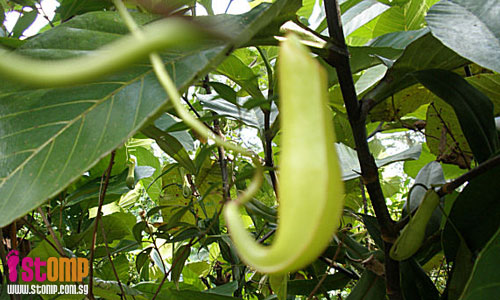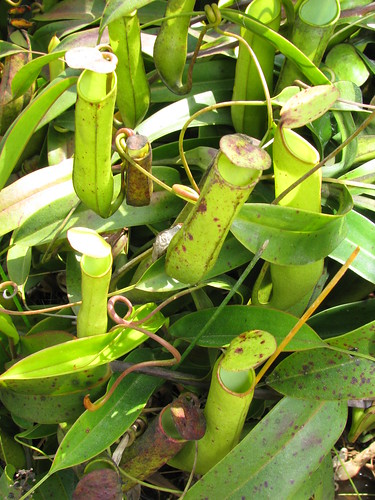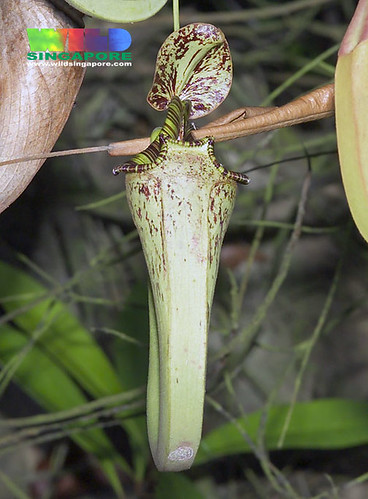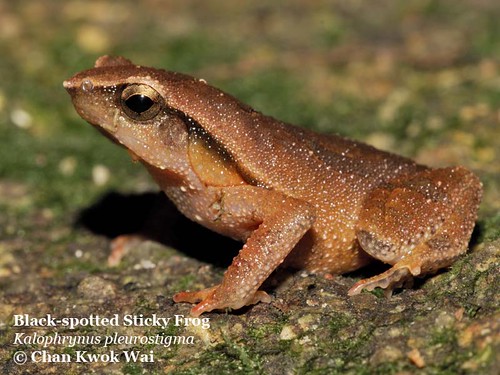
STOMPer Botanist saw the pitcher plant at Bukit Batok Nature Park and shares his knowledge of it. He says:
"These pictures were taken at the Bukit Batok Nature Park at Bukit Batok East Ave 2.
"This particular species, the pitcher plant (Nepenthes gracilis) is common and widespread in Malaysia, Singapore and Indonesia.
"It is easily spotted on road banks and cleared areas and grows well up to altitudes of 1000m.
"These carnivorous plants contain traps that can hold up to 50 cubic cm of liquid.
"Each leaf of the pitcher plant resembles a jug, or pitcher and has a lid to keep out the rain.
"An insect is lured by the bright colour and abundant nectar of the pitcher but the rim has a slippery surface.
"When the insect tries to get the nectar, it loses its footing and easily slides into the pool of liquid at the bottom.
"These plants make use of the proteins obtained from insects when their bodies are ingested."

The 120 species of tropical pitcher plants belong to the genus Nepenthes, and have a widespread distribution, from Madagascar and the Seychelles in the west, all the way throughout India, Sri Lanka and Southeast Asia, to Australia and New Caledonia in the east. It is in the Sunda region, however, that they are at their most diverse, particularly in Borneo.
There are 3 species of pitcher plant in Singapore:

Narrow-lidded pitcher plant (Nepenthes ampullaria), Central Catchment Area;
(Photo by NatureInYourBackyard)

Slender pitcher plant (Nepenthes gracilis), Tuas;
(Photo by Siyang)

Raffles pitcher plant (Nepenthes rafflesiana), Sentosa;
(Photo by Ria)
It is possible that the carnivorous habits of pitcher plants are an adaptation for obtaining nutrients such as nitrogen and phosphorus in soils that are deficient in these essential elements; in Borneo, pitcher plants are a prominent feature of heath forests or kerangas, where the soils are sandy and acidic, while here in Singapore, they can be found in the secondary forests known as adinandra belukar, which are also characterised for having acidic, nutrient-poor soils.
There are several interesting posts on pitcher plants in Singapore. Siyang and Kok Sheng have posted about their encounters with pitcher plants in the Kent Ridge area, while Gabriel Tan of eTour-Singapore.Com has a page detailing his encounters with the 3 different species of pitcher plant. He also mentions the Naked Hermit Crabs and the walks that we conduct on Sentosa. Joseph Lai has some excellent pictures of the 3 pitcher plant species, while Marcus has a post describing the unique features of each species, as well as some of the interesting relationships that pitcher plants share with some forest animals.
It's interesting to note that despite the digestive enzymes in the liquid within the pitcher, there are animals that actually live in pitcher plants. These include the larvae of many species of mosquitoes, midges and gnats, which feed on the remains of prey, and may play a role in breaking down large prey items and improving the rate of digestion. Otherwise, the enzymes secreted by the pitcher plant may act slowly, resulting in prey decomposing and leading to the growth of undesirable bacteria and fungi. These insect larvae are in turn preyed upon by the larvae of other fly species, such as the mosquito Toxorhynchites; larvae are voracious predators on mosquitoes, including their own kind.
Other creatures that utilise pitchers include a crab spider (Misumenops nepenthicola), which hides within pitchers and ambushes victims that are lured within, even descending down to retrieve insects that have fallen into the liquid. This spider can even submerge itself in the liquid and hide for several minutes if threatened.

Misumenops nepenthicola in pitcher of Raffles pitcher plant;
(Photo by Thomas Carow)
Crabs belong to the genus Geosesarma are also known to associate with pitchers; in Peninsular Malaysia, Geosesarma malayanum is known to raid the pitchers of the narrow-lidded pitcher plant to feed on the insects trapped within. And here in Singapore, a second species of crab, Geosesarma perracae, was found hiding within a pitcher.
Ng, P. K. L. & Lim, R. P. 1987. The taxonomy and biology of the nepenthiphilous freshwater sesarmine crab, Geosesarma malayanum Ng & Lim, 1986 (Crustacea, Decapoda, Brachyura, Grapsidae) from Peninsular Malaysia. Malayan Nature Journal, 41, 393–402.
Tan, H. H. & Ng, P. K. L. 2008. First record in Singapore of a nepenthiphilous crab, Geosesarma perracae (Crustacea: Decapoda: Sesarmidae). Nature in Singapore, 1, 201–205.

Geosesarma perracae in pitcher of narrow-lidded pitcher plant, Central Catchment Area;
(Photo from Tan & Ng, 2008)
Tadpoles of the black-spotted sticky frog (Kalophrynus pleurostigma) have even been found living inside the pitchers of the narrow-lidded pitcher plant.

Black-spotted sticky frog;
(Photo by kwokwai76)

Tadpole of black-spotted sticky frog;
(Photo from Frogs of Borneo)
In northwestern Borneo, the fanged pitcher plant (Nepenthes bicalcarata) has developed a fascinating relationship with an ant, Camponotus schmitzi. These ants nest only in the swollen hollow tendrils of the pitcher. While ants are a major prey item for many pitcher plant species, these special ants are able to crawl about the pitchers without slipping. They sip nectar from the glands on the rim of the pitcher, and even venture within the traps. Here they retrieve large prey items that would take too long for the plant's enzymes to digest, preventing the insect remains from putrefying. They are even able to dive into the liquid and swim around in pursuit of mosquito larvae.

Camponotus schmitzi retrieving insect prey from fanged pitcher plant, Brunei;
(Photo by clado)
Another amazing relationship takes place between Low's pitcher plant (Nepenthes lowii) and the mountain treeshrew (Tupaia montana). Instead of feeding on insects, the upper pitchers of this plant derive a large proportion of their nitrogen requirements from treeshrew poop.

Mountain treeshrew sitting on Low's pitcher plant, Sarawak;
(Photo by Ch'ien C. Lee)
These small mammals feed upon the nectar produced on the underside of the lid of the pitcher, which this species secretes in copious amounts. While feeding, they are perfectly positioned to defecate right into the pitchers. Consequently, these upper pitchers have all but lost the ability to trap insects, and instead obtain 57 to 100% of their nitrogen from treeshrew droppings.
Clarke, C. M., Bauer, U., Lee, C. C., Tuen, A. A., Rembold, K. & Moran, J. A. 2009. Tree shrew lavatories: a novel nitrogen sequestration strategy in a tropical pitcher plant. Biology Letters, published online before print.
To end off on pitcher plants, here's an interesting video from the BBC documentary series, The Private Life of Plants, on how the pitchers develop from the leaf tips.